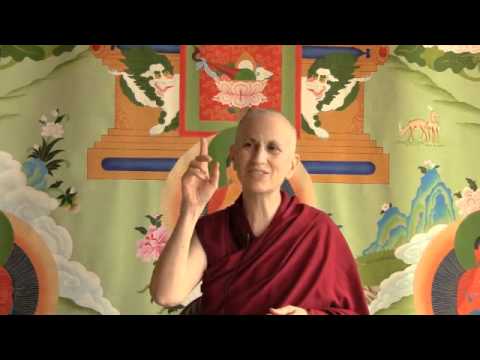The emptiness of beings
A talk on emptiness for the Bodhisattva's Breakfast Corner.
During the Bodhisattva Breakfast Corner the other day, I talked about some reflections with regard to our other kitty, Achala, passing away and how there is really nobody there that dies. We talked about how holding a narrow view about who a sentient being is is really quite limiting. One person afterwards told me that the particular motivation discussed was very helpful for her regarding reducing attachment to relatives. And it also works for friends, too.
Any time we’re attached to somebody else, we should ask ourselves, “Well, just who do we think they are?” [Venerable Chodron looks at the kitty, Manjushri, as he gets up and walks away] “Okay, you don’t want me to ask who I think you are.” [laughter] He says, “I know I am!”
When you examine what’s actually there, there is simply a body and a mental continuum, and that’s all. On the basis of these two, we label “person,” but when we try to find a person that is there—one that we can isolate and say, “This is exactly who the person is”—we can’t find it. There is just a body and a mindstream.
When we look at the body we believe we see something real and solid. We think there’s a truly existent body there, but then we see actually that it’s just a collection of limbs. There’s nothing there that really is a body, but on this collection of limbs we label it “body.” Similarly, when we say “mind,” there is a collection of many different kinds of consciousnesses: primary consciousnesses, mental factors, all different sorts of moods, feelings, perceptions, and mental abilities. On the basis of all of those collected, we label “mind.” But aside from that collection and what’s labeled in dependence on it, there’s no mind there. In the same way, apart from the collection of limbs and the label of “body” in dependence upon them, there’s no body.
It’s very interesting how when we’re quite attached to somebody we have so much emotion about them. It started out with a pet, but it could be a human being or whatever it is that we’re so attached to and so worried about, that we don’t want to be separated from. Then we examine: “Well, what exactly is that person? What exactly is that being?” When we can’t find something that we can isolate and say, “This is them,” initially we have some kind of feeling that we’ve lost something precious.
We think, “There’s my precious somebody who I thought was really there,” and we want to hold on to them and grasp them some more. But when we really think about the pain and misery that the grasping causes, we begin to realize that not finding some kind of truly existent person there is actually a relief. It means that there’s nothing solid there to cling on to so there’s nothing solid there to lose. Then we’re relieved from the pain of the grasping.
But at the beginning, we don’t realize that painful grasping. We want there to be a real person, and we feel this tremendous loss if it goes away. But the more we practice the Dharma, the more we realize how painful attachment is, we want to counteract it. And then seeing the lack of a findable being there actually seems to be a relief.
In the same way, we can apply this to ourselves when we think of ourselves dying: “That which we call “me” is just labeled on the combination of body and mind. It’s nothing more than that.” There is no concrete “me” to fear that will die because there’s no concrete “me” here to start with. Again, that comes to our grasping mind as a big shock, and we’re quite upset about it because we’re really sure that we’re quite definitely there as the center of the universe. But, again, the more we see that ignorant beliefs lead to afflictions, lead to karma, and lead to rebirth, then when we see the emptiness, we really see what a relief realizing emptiness brings.
You can see that for the realization of emptiness to really have a good effect on our mind we also need a lot of prior work. We really need to see the disadvantages of attachment; we need to see the disadvantages of craving and clinging and grasping. We really need to see the faults of cyclic existence because without seeing all of that first then when we hear some talk of emptiness, we just get frightened and kind of freaked out. We want all that stuff simply because it’s familiar. If we do this work beforehand, then understanding emptiness is not frightening: “Ah, relax—I don’t need to worry about anything.”
Venerable Thubten Chodron
Venerable Chodron emphasizes the practical application of Buddha’s teachings in our daily lives and is especially skilled at explaining them in ways easily understood and practiced by Westerners. She is well known for her warm, humorous, and lucid teachings. She was ordained as a Buddhist nun in 1977 by Kyabje Ling Rinpoche in Dharamsala, India, and in 1986 she received bhikshuni (full) ordination in Taiwan. Read her full bio.


